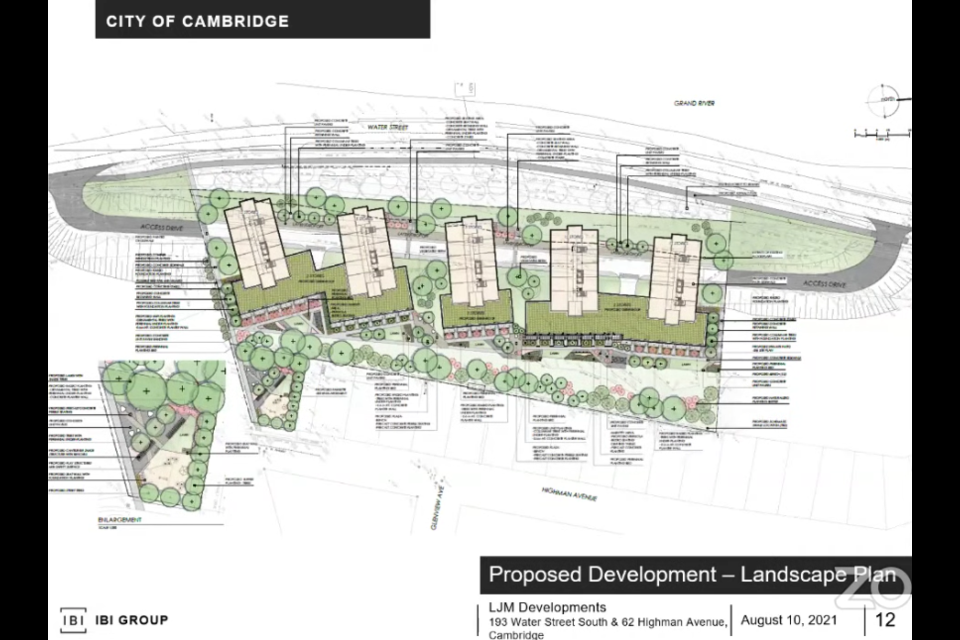Opposed was the key word used by residents calling in at a Tuesday public meeting about a proposed set of five, 15-storey apartment buildings on Water Street South.
"I firmly believe that this development should not move forward," said Crystal Harvey-Robertson, who was calling in to express concerns around the proposed development on 193 Water St. S. "It's wrong for this neighbourhood and wrong for the Galt community. The proposed build does not fit in with this neighbourhood. The developer has the potential to destroy the multi-generational neighbourhood."
The application being brought forward by LJM Developments Inc. also includes some wraparound townhomes and will add 991 dwelling units to the area.
To make this number work, the developer is requesting some official plan and zoning bylaw amendments. The land is bookended by two properties that are culturally significant, one of them is under a provincial designation, while the other is on the city's registry. Both of these will remain intact, the application says.
Karen Scott Booth, a member of the Cambridge Branch of the Architectural Conservancy of Ontario, said this goes against the city's official plan, the neighbourhood and will have irreversible environmental and heritage impacts.
"Due to the proximity of this site with identified cultural resources and landscapes speaks to the significance of this area and requires a Cultural Heritage Impact Assessment be undertaken," she said, adding, "We do not support, nor should council allow, the changes from zoning."
The wooded area that will be home to the buildings will be cleared of at least 660 trees, 275 of which would require a city permit. The developer proposes a two to one replanting program with some trees going in the property and others along the rail trail. As well,a new crosswalk is being proposed to connect residents who will occupy the development to the Cambridge-Paris rail trail.
Callers were unconvinced that such a high density was the way to go.
"Five 15-storey buildings are too high and too aggressive for this part of the city," said Craig Robertson. "The mature neighbourood has been established for 70 years and the current proposal is not in keeping with it."
Further, the removal of trees and how it would affect the biodiversity that uses them as home was also a main concern.
"Everyone is counting the 660 trees but no one is counting the siblings growing beside them," said Mike DeBrusk, a resident of Highman Avenue. "We need good decisions to make sure we keep our green space. We have many families that live in these green spaces. They have no choice. We need to save them and we need to save our animals. These animals are defenceless; they have no way of fighting."
Christina White, also a resident of Highman Avenue, said she'd read the arborist's report submitted with the application and had gone down to check out the trees that the report marked as dead.
"I took it upon myself to check out the trees that are tagged as dead," she said. "They don't look like that at all. They look like they're healthy and thriving."
The developer also proposes a parkette in place of 62 Highman Ave., which is being posed as access for the neighbourhood abutting the lands.
"We don't want a parkette," said Robertson. "It seems really unnecessary to destroy that house. Yes, it seems that this gives access to the trails and residents in the development access to schools. But it seems unnecessary."
As well, the application states the entire subdivision will be built in phases, which to the residents means repeated construction periods.
"If they take the trees down, where is all of the dust and debris from the construction going to go? Straight into our backyard," said White. "It's just really concerning as residents on Highman (Avenue) for the environmental impacts."
To Veronica Macdonald, removal of trees and the consequent construction, meant pushing animals from the woods into people's home.
"I am concerned about the amount of vermin that's going to be kicked out of there and is going to start rummaging through our garages and sheds," she said.
Even though residents registered their issues, they did acknowledge that development was bound to happen.
"Development is inevitable but we have to look at a balance of nature and people," said Robertson.
Other said the development should be in keeping with what's already established in the area.
"We have a very old city core," said DeBrusk. :Let's keep what our ancestors built the way it is. We don't want a Toronto."



